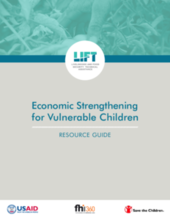This is a resource guide designed for PEPFAR implementing partners to help them effectively design and implement economic strengthening activities for vulnerable children. The guide lists gender, age, social inclusion, conflict, accessibility, chronic illness, and environment as reasons that certain children and households are vulnerable.
This guide provides critical steps and considerations for sound decision-making and steps to determine resource allocations for household economic strengthening for vulnerable children. Household economic strengthening is the process by which individuals and households improve their living conditions by participating in any number of activities that increase assets (physical, financial, human or social) and/or their capacity to obtain them. This guide discusses the most effective household economic activities and includes a number of pre-planning exercises to help partners think about the needs of their target population and communities. Household economic strengthening activities are meant to meet households and individuals at the level of their current capabilities, as well as help them move up the economic ladder. These activities are based on the “Five Knows” from PEPFAR’s Guidance for VC Programming, which emphasizes that the partners know the state of their: epidemic, children, context, response, and costs. These techniques help the partners focus on what vulnerable children really need and what factors should be addressed in a household livelihood assessment. This document provides tools to help with the assessment and also provides monitoring and evaluation tools.
The guide emphasizes the importance of observing measurable goals to determine the effects these activities have on vulnerable children. Potential benefits to vulnerable children include improved quality of care, increased income, financial safety, sustained quality of care, school attendance, and safety and security.

